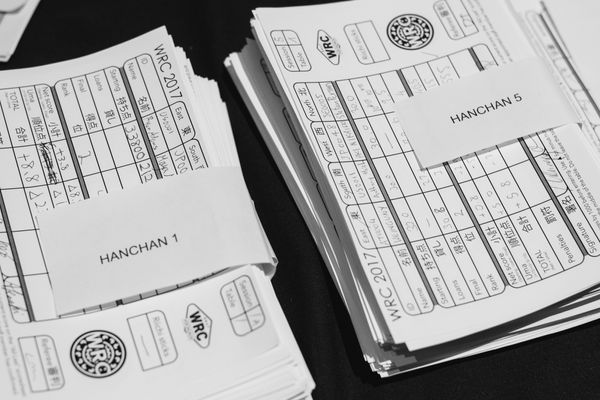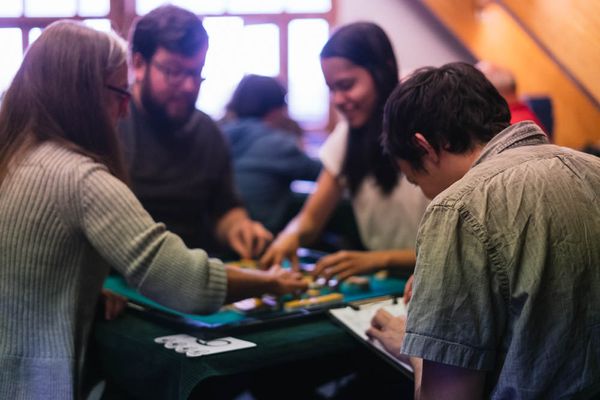Completely unofficial WRC manner guidelines
It’s less than a week until the World Riichi Championship in Paris will begin, marking an unprecedented clash between some of the best professional players from Japan and others from all over the world. Are you excited? We at osamuko sure are.
We thought it might be a good idea to ease some of the doubts or insecurities players might have in relation to general manner do’s and don’ts and came up with a few points laid out here. Some of them might be common sense but we’ll still mention them because of our experiences in a number of western tournaments.
Reachmahjong already published some very good advice on general Japanese Mahjong manners a while back, make sure you read it. We will reiterate a few important points and add some here.
**Disclaimer:** ** The advice here merely reflects our personal opinions, experiences and observations. This article is in no way affiliated, related or binding to the official WRC. These guidelines are part of common Jansou manners as well. ** For gods sake, don’t use tile racks or other “tools” on the table.It’s common to only say the score of a hand when you’ve won one. Individual Yaku are usually not mentioned. It shouldn’t be too big of a problem if you do mention to count the han, but this is something most Japanese won’t do.
There has been a lot of controversy about the use of scoring sheets. and it’s not entirely clear to us how the final verdict in this matter turned out.
The rules state that *“All players at the table are responsible for ensuring that winning hands are scored correctly”, *so in theory you aren’t actually required to know the scoring table as long as someone can help out. But please remember, this is supposed to be a World Championship. Having to look at a sheet to determine the payments of a 2/40 Tsumo or asking the other players about it is not exactly what one would expect of a competition at this level.
Don’t check your next draws or (possible) ura-dora from the wall after a hand has ended.
When you’re dealer, always place the dice to your right corner. Honba and Riichi sticks in the pot also go there (behind the dice).
It looks like this tournament will use point sticks for scoring, whereas the normal EMA method was always to write scores on paper. Make sure you know how a 10,000/5,000/500 point stick looks like if you’ve never used them for scoring.
A remaining problem might be knowing the exact scores of everyone at a table during the game, as automatic tables with score displays won’t be used (at least not until the final). While the sticks will be visible in the mat trays, discerning whether those are 8, 9 or 10 100 point sticks might pose an issue.
We’re not quite sure what the best course of action is here. Asking after a hand has ended should surely be no problem, but asking during the current hand? Keeping personal notes on scores?
In some European tournaments they used round plastic chips as the Honba (counter) indicators. In Japan they use a 100 point stick for each Honba instead.
The Honba indicator sticks are taken from the current dealer’s bank and are returned to him when the Honba are reset to zero or the dealer rotates, where the new dealer is in charge of providing the Honba.
If you don’t have a 1000 point stick for Riichi or 100 for placing a Honba, it’s generally no problem to ask the other players if they can exchange sticks during a hand.
Take your time to think when you need to, but discard swiftly when you made up your mind. Some players tend to put their discard tile down, hold their finger on it and slowly push it to the discard pond or slowly drop the tile and hold it down for a moment with their thumb and index finger, making it difficult to quickly recognize what was actually discarded.
I know from a few tournaments I’ve been attending in Europe that some players count the han value of their hand by flipping tiles from their discard pond. Don’t do that. In general, leave the table in it’s original state until everything is settled and ready for the new shuffle.
It can get messy if someone has an objection and previous situations have to be reconstructed.
Similarly, when you win a hand by ron, don’t take the winning tile from the other player’s pond and place it at your hand. This is usually only done for TV broadcasts. Though I’m not sure what plans Mondo21, an entertainment/gambling TV station from Japan that is present there, will have for the event.
You don’t have to put tiles you draw on top of your hand, this is mainly done for the sake of TV broadcasts as well.
Place your open sets from calls/closed kan to your right and not in front of you.
Avoid talking to yourself, notorious or over-emotional reactions during the game like laughing when you’ve discarded the 10th terminal tile. Some actions might not sit well with some of the Japanese higher ups.
On the topic of shuffling tiles: Don’t be too violent, nor should you click your tongue and roll your eyes in exaggerated annoyance every time a tile is turned face-up during the shuffle either.
When you mess up stacking the wall and too many tiles become visible, re-shuffle.
It’s likely that many of Japanese players (and maybe some others) will have a hard time communicating even in basic english. To make things easier and avoid misunderstandings, we recommend knowing a few basic Japanese Mahjong-related terms like the following:
– Obviously the Japanese Yaku names, see the WRC rulebook
– Oya – Dealer/east seat
– Agari Houki – Dead Hand
– Honba – Counter
– Shimpan – Referee
– Agari – A win (of a hand)
– Atama Hane – The “head bump” rule that applies in case of double/triple ron, only the player closest to the discarder receives points.
There are also a million other Japanese Mahjong terms you can learn about if you wish.
Be competitive, but take it easy.
If you have anything to add or any questions, feel free to leave a comment.
PS:
Rumor has it that the WRC final will be played with automatic tables.



